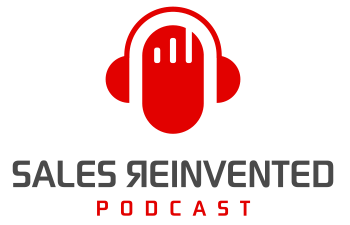Episode #447: Scott Chepow

Meet
Scott Chepow
Scott Chepow is a global negotiation strategist specializing in consumer goods. He advises senior executives across the sector on how to improve their commercial effectiveness through negotiation expertise and is focused on improving the business mindset of organizations.
Our Mission Is To Change The Negative Perception Of Sales People
Our Vision Is A World Where Selling Is A Profession To Be Proud Of
What if the key to success in any negotiation was in the preparation before you even sat down at the table? In today’s episode of Sales Reinvented, Scott Chepow, a global negotiation strategist, dives into the critical role preparation plays in successful negotiations.
Scott shares how planning, understanding the stakes, and conditioning your counterpart are the cornerstones of securing favorable outcomes. Whether you’re closing a major deal or navigating everyday discussions, Scott’s insights will equip you with the tools you need to approach every negotiation with confidence and strategic foresight.
Outline of This Episode
- (0:58) The difference between negotiation strategies and tactics
- (2:36) Scott’s go-to strategy for high-stakes deals: The growth strategy
- (3:20) Scott reveals three of his most effective negotiation tactics
- (4:32) The importance of planning in negotiation
- (5:47) Understanding the role of conditioning in negotiation
- (6:30) The most effective negotiation strategy to use
- (8:16) Recognizing and countering aggressive negotiation tactics
- (10:26) Scott’s do’s and don’ts of negotiation strategy and tactics
- (12:23) Showcasing the power of planning and communication
The Core of Negotiation: Strategy vs. Tactics
When it comes to negotiation, strategy and tactics play distinct roles, but both are essential. Strategy serves as the guiding direction, the framework that informs all moves within the negotiation. Tactics, on the other hand, are the specific actions taken to influence the process and outcomes. According to Scott, Sun Tzu’s wisdom rings true in this context: “Strategy without tactics is the slowest route to victory. Tactics without strategy is the noise before defeat.”
Understanding the difference allows negotiators to approach the negotiation table with a clear plan, confident in their ability to adapt tactics to the situation. While the strategy sets the tone, the tactics ensure that the negotiation unfolds in a way that maximizes value for both parties involved.
Scott’s focus on a Collaborative Growth Strategy
Scott’s approach to high-stakes deals is consistent: he focuses on a collaborative growth strategy. This strategy aims to create mutual value through collaboration, fostering an environment where both parties are motivated to work together toward a profitable and sustainable outcome. By identifying what both sides value and working towards a shared goal, Scott has consistently achieved successful results.
For Scott, the growth strategy is not just about making a deal but about creating long-term partnerships. His approach shows that the key to success in high-stakes negotiations lies in the mindset of cooperation, not confrontation.
Tactics for Gaining Leverage
While strategies are the big-picture plans, tactics are the tools that help you gain leverage and move the negotiation in your favor. Scott shares three of his go-to negotiation tactics: holding off-the-record meetings to encourage collaboration, linking multiple issues together to prevent them from becoming isolated and contentious, and using silence to create space for reflection and control.
Silence, as Scott points out, can be particularly powerful. It’s a tactic that allows the negotiator to remain calm, gather their thoughts, and manage any conflicts that arise during the discussion. By staying quiet at the right moments, negotiators can steer the conversation without over-committing or losing control.
The Power of Preparation and Conditioning
Scott recounts a negotiation where he was advising a client on adjusting payment terms with a major retailer. The team had anticipated that the retailer would request a change in payment terms, so they meticulously planned their strategy ahead of time. They knew this request would come up and prepared their response: a clear, consistent communication plan that emphasized why the payment terms couldn’t be altered.
When the retailer’s chief merchant called, demanding the adjustment, Scott’s client stuck to the agreed-upon message, repeating it calmly and confidently. This strategic repetition of their position eventually prompted the merchant to ask, “What else can we do to create value?”
Rather than being caught off guard or pressured into a hasty decision, Scott’s client was able to pivot the conversation and work toward a mutually beneficial agreement. This strategic approach created millions of dollars in value for both parties, showcasing the power of careful preparation and communication in negotiations.
This example illustrates how thorough preparation can make a significant difference when unexpected moments arise, allowing you to stay composed and steer the conversation in your favor.
Connect with Scott Chepow
- Connect on LinkedIn
Connect With Paul Watts
Audio Production and Show notes by
PODCAST FAST TRACK
https://www.podcastfasttrack.com
Learn More About Scott Chepow
What was a pivotal moment in your career that shaped your approach to negotiation, and how did it influence your strategy and tactics?
It wasn’t necessarily a pivotal moment but a time early in my career when I sold beverages to both large retailers and independent c-stores. It taught me that no two customers are the same despite their similarities on the surface. You need to understand the customer and understand what negotiation strategy and style fits the customer.
Can you share a specific negotiation tactic that has consistently helped you close deals more effectively? Please provide an example where it worked.
I’ve used Linking the Issues effectively to not just close deals but to create incremental value beyond my initial expectations. Linking the issues takes two separate issues and brings them together using a contingent relationship.
What is the most challenging negotiation you’ve ever faced, and what strategy or tactic helped you turn it into a win?
One of the more challenging negotiations I have been a part of started out with a retail ask to which my client responded a month later with a price increase. As you can imagine this negotiation was rife with conflict. We leveraged escalation and off the record meetings to come to a profitable deal for both parties.
What are your top three must-have tools, frameworks, or resources that sales professionals should use to improve their negotiation skills?
There are three things every negotiator needs to have to be effective. First, an understanding and mastery of behavioral negotiation that allows them to be a balanced negotiator, with the potential for success in any type of negotiation maximized. Second, a framework for strategic negotiation that allows them to have a strategic plan that deals with the three elements of negotiation- people, process, and power- so that they can de-risk negotiation. And finally, a tactical planning tool that allows them to plan the negotiation flow from beginning to end so they’re always on top of the ‘next step’ in negotiation.
With buyer behaviors evolving and AI playing a larger role in sales, how do you see negotiation strategies and tactics changing in the future? What should sales professionals do to stay ahead?
I see AI being extensively deployed on the buy side in distributive negotiations and I see different forms of generative AI being used currently on the sell side to craft messaging. For sellers to stay ahead of the curve, they need to do two things at a minimum. First, save your negotiation data. The more data you have, the more accurate predictive modeling will be. But you have to start saving it! Second, be innovative in your offerings. The more innovative you are, the less likely you are to negotiate with a machine because the machines don’t know how to handle value creation negotiations… at least at this point.
What are some simple but powerful negotiation tactics that most salespeople overlook?
- Leveraging silence- many salespeople are not comfortable with creating the constructive tension that comes with silence. If you’re not comfortable with silence, you’re undermining your own negotiation skillset.
- Deadlines- too often sellers are afraid of putting time pressure on the other party. Deadlines can be collaborative and can force both parties to move towards a deal. Don’t be shy!
- Asking why- Always seek to understand the rationale and never forego the opportunity to seek clarity.
Share This Episode, Choose Your Platform!
